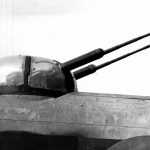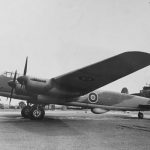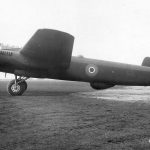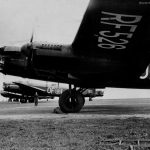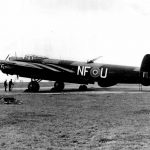Bristol B.17 mid-upper turret with twin 20 mm Hispano (Mk IV or V) cannons
Boulton Paul Type D tail turret with Automatic Gun-Laying Turret (AGLT) and 2x 0.5 in (12.7 mm) M2 Browning machine-guns
Lincoln B Mk.2 SX991 of No. 58 Squadron RAF
Lincoln RF385 DX-G of No. 57 Squadron RAF
Lincoln Mk.2 RF370 2
Dorsal turret of Lincoln PW925
Lincolns RE322, SX975 and RE323
Lincoln RF355
Lincoln RF370
Prototype Lincoln PW925 with open bomb bay doors
Lincoln PW925 1944
Lincoln prototype PW925 in its original form in the summer of 1944
Lincoln nose view
Lincoln Mk II March 1945
Lincoln RF526 of No. 97 Squadron RAF
Lincoln interior
Lincoln Ringway Airport 1944
The first prototype Lincoln PF925
Lincoln NF-U of No. 138 Squadron RAF
Lincoln 1944
History
Chadwick’s design staff began work on the Avro Type 694 Lancaster Mark IV in December 1942, the proposed design retaining 80% of the earlier bomber’s structure, including the front and centre fuselage sections and the entire wing centre section. The outer wing sections were enlarged by about 10% and the rear fuselage lengthened by 13%, the extra space thereby provided being used to accommodate additional fuel. Power was to be provided by 1,750hp Merlin engines with two-stage, two-speed superchargers, and a much sturdier Dowty undercarriage was to be provided to support the greatly increased operating weight. The Lincoln anticipated Air Ministry Specification B.14/43 to which it was built and the unarmed prototype PW925 first flew at Ringway, piloted by Capt. H. A. Brown, on June 9, 1944. Similar in structure to its predecessor, it used a standard Lancaster tail unit (with enlarged rudders) to speed production, but flush riveting gave place to the mushroom type. Merlin 85 engines drove Rotol three bladed propellers and were arranged as detachable power units in low drag, armour plated cowlings with annular radiators of the type air tested in Lancaster VI ND784/G.
PW925 was fitted later with a Glenn Mart in mid-upper turret, but subsequent prototypes PW929 and PW932 and all production Lincolns had the Bristol B.17 Mk. II, with Boulton Paul F and D type in nose and tail, all mounting (in the Lincoln B. Mk. 1) twin .50 in. machine guns. Two .50 in. guns in the nose turret of the Lincoln B. Mk. 2 were remotely controlled by the bomb aimer, two others were in the tail and one in a ventral position. The mid-upper mounted two 20 mm. British Hispano cannon. Twelve Lincoln B. Mk. 1 were converted to Mk. 2 by Short Bros. and Harland Ltd. in 1947. The alternative fitment of H2S Mk. IIIG or IVA radar bomb sights gave rise to two sub-variants, the Lincoln B. Mk. 2 (IIIG) and B. Mk. 2 (IVA). Flown by a crew of seven, it had the magnificent handling qualities of the Lancaster but came too late for service against the Japan.
Contracts awarded to the Lancaster Group for 800 Lincolns were consequently cut back to a small number for use as standard heavy bombers in th e postwar RAF. Production initiated by A. V. Roe and Co. Ltd. at Manchester and Yeadon was completed by Armstrong Whitworth. Lincolns were first issued to No. 57 Squadron, and No. 44 Squadron for Service trials in September 1945 and the type made its first public appearance when RE325 was demonstrated at a Farnborough “At Home” on October 29 that year. 3 Lincolns which flew 20,000 miles from Scampton to Santiago, Chile, and back in October 1946 were the first of many globetrotters. 16 Lincolns of No. 617 Squadron flew nonstop Binbrook-Gander on July 23, 1947, flew over New York in formation, and visited Los Angeles and Canada before returning on September 9. No. 44 Squadron flew to Southern Rhodesia in June 1948; No. 97 to Singapore in the same year; and 6 from No. 9 Squadron took part in Exercise “Sunrise” in the Canal Zone before paying a goodwill visit to Pakistan in October 1949.
The last Lincolns in operational service were the radar development aircraft of No 151 Squadron, which were disposed of in May 1963.
Serial numbers
Prototypes: PW925, PW929 and PW932
Mk.1 (82): RA628 – RA655, RE227 – RE268, RE281 – RE288, RF333 – RF334, SS713- SS714
Mk.2 (447): RA656 – RA658, RA661 – RA693, RA709 – RA724, RE289 – RE325, RE338 – RE380, RE393 – RE424, RF329 – RF332, RF335 – RF370, RF383 – RF427, RF440 – RF485, RF498 – RF539, RF553 – RF577, SS715 – SS718. SX923 – SX958, SX970 – SX993, WD122 – WD133, WD141 – WD149
B.Mk.XV (Canadian): FM300
B.Mk.30,30A and 31 (RAAF): A73-1 – A73-73
Source:
A.J. Jackson: Avro Aircraft Since 1908
Francis K Mason: The British Bomber since 1914
